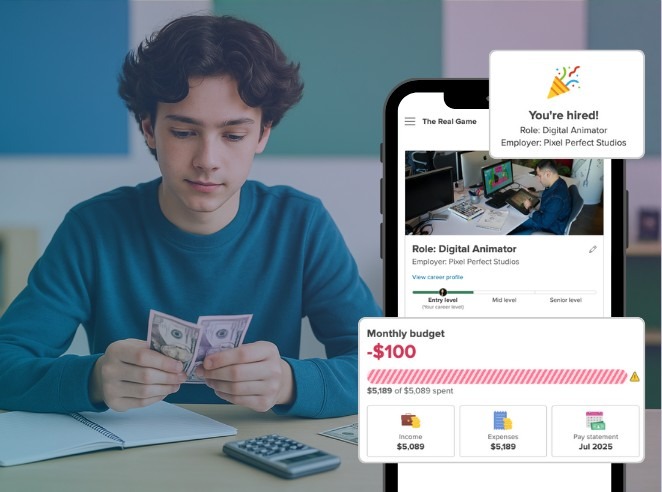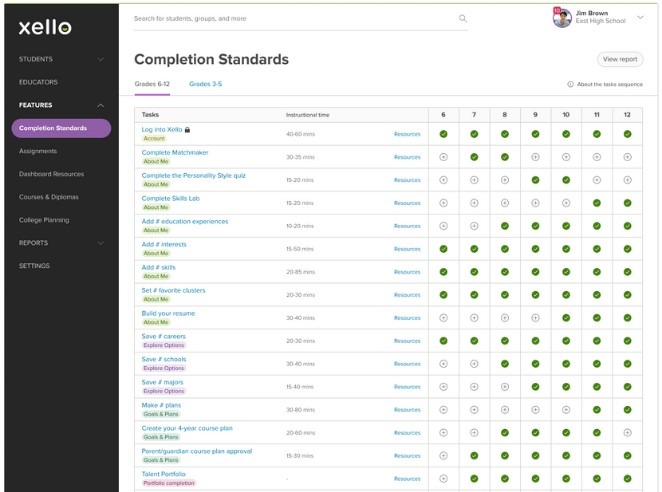Now more than ever, there’s a national focus on preparing students for success. One way is by instilling college and career readiness requirements.
The introduction of the Every Student Succeeds Act (ESSA) back in 2015 revamped the nation’s approach to solving this problem — pushing down the responsibility of building future readiness plans to each individual state. The Collaborative for Student Success describes the change well when they say it “places states squarely in the driver’s seat by empowering them to develop their own accountability systems that measure student progress and affording them the authority to determine how best to improve student and school performance.” This delegation allows for amazing flexibility and powerful autonomy at the state level that hasn’t been present in decades. But with great power comes great responsibility.
State level authorship of plans creates an inherent expectation for success. Benchmarks and goals wouldn’t be created if they weren’t achievable — right? Add to that some fairly stringent reporting and measurement criteria required by the Federal Department of Education, and districts are feeling the pressure to perform. But with the right initiatives in place for students, teachers, and the community, compliance doesn’t have to be all-consuming. Here are five ways you can meet your college and career readiness requirements and maintain your sanity as you strive for compliance this school year.
Support Your Educators in Meeting These New Demands
You’ve likely spent the last few years focusing on understanding new federal requirements and working with your State Education Agency to build custom plans for your state and district. This school year the spotlight is on your educators — the principals, teachers, and counselors responsible for ensuring schools and students meet the demands of these new standards. Your district’s achievement of college and career readiness goals rests on their shoulders and, without the right support, it can feel like a heavy load to bear.
You can help de-stress the situation by positioning this challenge as an opportunity for your educators to grow as leaders. Empower them with the skills, knowledge, and resources to make them feel confident tackling this topic with their students. When teachers’ confidence increases, and when they feel competent in their abilities, classroom instruction improves (Journey to Teacher Empowerment, 1999). That means a smoother road for your schools and students in their pursuit of newly minted college and career readiness goals.
Education consultancy, Education First recommends, if there are funds available, encouraging educators to look for professional development opportunities to enhance their teaching approach to meet the demands of new college and career readiness standards. Maybe it’s a workshop on assessments or an online course about teaching social-emotional skills, or perhaps a conference that will expose them to new tools or frameworks. If funds are tight, development can also take a more informal form. Simply encouraging schools to work together and fostering a structure for collective practice can increase productivity and performance (Whitaker, 2003). Creating a steering committee that brings principals and teachers together from various sites can quickly expose opportunities, reveal new ideas and create more consistency within your district when it comes to tackling college and career readiness.
Support can also come in the form of turning your educators onto relevant resources and tools. According to a 2017 survey, “teachers spend seven hours per week searching for instructional resources (both free and paid for) and another five hours per week creating their own instructional materials.” Pointing your educators in the direction of high quality, age-appropriate content and materials can be a great demonstration of your support. Look for ready-made lessons that align with your district’s indicators for success — if they’re online and come with built-in tracking and reporting, even better.
Define Your Measurement Strategy
New requirements provide a great opportunity to evaluate whether you’re measuring the right things. Most assessments only measure a sliver of the skills students need for success after graduation. Now is the opportunity to take stock of what you’re evaluating, critique the information you’re getting back, close any gaps and streamline the process. Which assessments align best with your college and career readiness requirements? Are there assessments that you’re not finding useful? Which information has the most benefit to teachers, parents and your district? A handy, free resource to help critique your assessments can be found here. Inevitably no single assessment will be able to do it all, but now is a great opportunity to ensure you have a balanced approach and put programs in place to evaluate both students’ academic and social-emotional readiness for the future.
But don’t stop at just evaluating what you’re measuring, also consider how you’re measuring. There are lots of tools and programs out there that deliver assessments and help you report on indicators for college and career readiness. It’s easy with compliance pressures to prioritize reporting needs first and, inadvertently, compromise on the student experience. Get feedback from parents and educators about how their students are responding to assessments and preparatory activities. Is the experience personalized enough? Does the current career interest survey genuinely build their self-knowledge? Are students excited after completing their careers assessment and genuinely eager to explore further? Do teachers have to force them to stay on task, or are they fully engaged in class? Programs that help personalize the student experience and make it fun (while still supplying you with measurable results) won’t just help prove mandate compliance, they’ll actually grab the attention of your students and help them internalize what they’ve learned. You’ll go from simply measuring assessment results to really moving the needle in student performance and participation.
Find Efficient Ways to Deliver Personalized Learning and Track Results
Whether your district is a few hundred, or a few hundred thousand, consistency across your schools can be a challenge. To meet your college and career readiness goals it’s critical to get educator buy-in and student engagement. The question becomes how to do this in a scalable, but yet still personalized, way?
Look to technology to help drive efficiencies. In addition to helping your educators deploy programs to meet your mandates, web-based college and career readiness platforms can ensure every student across your district is receiving a consistent experience. Best-in-class programs personalize the student experience to make it more relevant. Try to find a program that helps kids build self-knowledge and then presents career and college options matched to their interests, skills, and personalities. Ideally, these matches come with supporting context that explains why certain careers or post-secondary options are the right fit, helping students better understand who they are, and how that impacts what they want to become. Take personalization a step further by choosing a program that also allows students to customize their account. Programs that encourage students to tailor their portfolio by letting them add relevant articles, images, videos, and experiences help create pride of ownership. Students login each day to a space that reflects their unique personality and an environment that reflects their individual needs and stage in the college and career planning process. Going online also means plans can easily evolve with them over time, and eliminates the need for your educators to recreate student portfolios each year.
For your educators, search for systems that help eliminate time-consuming administrative tasks. The right college and career readiness software should automatically track against key indicators within your mandates. Look for systems with ready-made (and easy-to-read) reports that measure things like student engagement, progress towards graduation and attainment of necessary skills for success. Programs that integrate course planning and provide alerts for when students might be off-track are extra helpful for time-strapped teachers and counselors.
Be Strategic with Your Spending
Professional development for educators, assessment tools and engaging content are all amazing tactics, but they come at a cost. Translating these ideas into reality means thinking strategically about funding.
More control at the state level means districts and schools are now more empowered to allocate money where it matters most. Critically examine where your district dollars are being spent and whether there’s enough money flowing into your college and career readiness initiatives to make the necessary impact. With formula and discretionary grants, as well as funding earmarked for different initiatives you have options.
If your district qualifies for Title I funding, consider how to potentially stretch these funds to benefit the greatest number of students. For example, schools enrolling at least 40% of children from low-income families are eligible to use Title I funds for schoolwide initiatives designed to upgrade their programs to improve achievement for all students (in addition to their lowest achieving pupils). For Title II funding consultants from Education First, recommend allocating some of those dollars towards high-quality professional learning for your administrators and teachers or funneling some of those dollars towards recruiting and hiring for schools with the highest need students.
And don’t forget about the funds associated with the newly signed Strengthening Career and Technical Education for the 21st Century Act (Perkins V). Recently increased by $70 million for the fiscal year 2019, these funds are specifically allocated for CTE related initiatives. Evolving from Perkins IV, Perkins V specifies that to qualify for funding plans should align with each state’s ESSA plan. The updated legislation also re-emphasizes the importance of offering comprehensive career exploration opportunities for every student, regardless of background or socio-economic status. This includes providing information about job training, work-based learning opportunities, financial literacy and content that prepares students to be successful in any range of secondary or post-secondary education options (including apprenticeships).
For discretionary competitive grants, consider exploring if schools in your district qualify for money through programs like GEAR UP, or The Teacher and School Leader Incentive Program Grant Competition. These funds are potentially a great way to supplement budgets and other Title funding to ensure your district is adequately investing in educator and student success based on current gaps and goals.
Engage Parents in the Process
Everyone is entering into somewhat unchartered territory when it comes to meeting new college and career readiness mandates. But, as the saying goes, there’s safety in numbers. Collaborating with parents can go a long way in strengthening plans and ensuring success.
The first step is securing parent representation in conversations about college and career readiness and providing them with avenues to offer feedback. Consider including parents in cross-functional working groups as a way to efficiently add their perspective to the mix. For instance, Yakima School District, a Xello client in Washington, formed an 11 person committee that included representation from parents, teachers, counselors, and principals to help steer their college and career readiness initiatives. The result was a cohesive and well-rounded plan that incorporated everyone’s perspectives and created alignment on a go-forward plan.
Because not all parents have the time for in-person meetings, be sure to offer multiple channels for feedback to increase accessibility. Periodic surveys are a great way to engage parents and expand your reach when it comes to collecting input. They can be easily translated into multiple languages, collect both qualitative and quantitative info and be completed when it’s most convenient.
Another key to great communication with parents is facilitating easy access to information. Publicly posting and distributing updates, timelines, and other relevant information helps create a culture of transparency and offers an efficient way to keep parents in the know. Consider building a stand-alone page on your website with relevant information about your district’s college and career readiness goals and plans. Be sure to include key dates, contacts, and ways parents can get involved. And don’t get bogged down with complicated policy jargon — keep language straightforward and clear so parents can easily follow along with what’s happening, acquire the needed context and get on board with your plan.
Final Thoughts
The reality is, there won’t be a universal recipe for achieving optimal college and career readiness. It involves a mix of people, processes and programs of which you’ll need to determine the best combination of elements for your district. But starting out by thinking about these core initiatives, and how best to implement them with your educators, will get you on the right path towards more easily and meaningfully meeting mandates.




